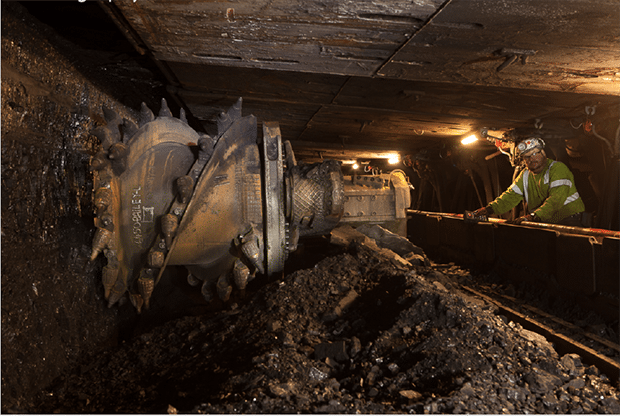Continued Toll on Coal; More Companies File Bankruptcy
The post Continued Toll on Coal; More Companies File Bankruptcy appeared first on POWER Magazine.

The struggling U.S. coal industry, decimated by falling demand for the fuel from the power generation sector, and hit hard by low prices during the coronavirus pandemic, saw two more mining companies declare bankruptcy this week.
White Stallion Energy, which operates in Indiana and Illinois, and Lighthouse Resources, a coal company with mines in Wyoming and Montana, filed for bankruptcy in the U.S. Bankruptcy Court in Wilmington, Delaware, on Dec. 2 and Dec. 3, respectively. The U.S. Energy Information Administration (EIA) has reported that the nation's power sector consumed 30% less coal in the first half of 2020 than during the same period last year, as demand for electricity fell due to the pandemic, and natural gas and renewable energy continued to take market share from coal.
In light of the challenging market conditions and other impacts on our business from COVID-19, we have been required to reduce costs and reorganize our business, resulting in the reduction of our workforce in Montana," Lighthouse CEO Everett King said in a statement. We are deeply saddened by this impact on individuals, families and communities."
Peabody Issues WarningPeabody Energy Corp., the largest U.S. coal producer, in November said it could seek bankruptcy protection for the second time in five years if market conditions do not improve. Several other coal companies, including Blackhawk, Blackjewel, Cambrian, Cloud Peak, Piney Woods, and Trinity, all have filed for bankruptcy this year.
Westmoreland Mining LLC, a group of creditors that took over Westmoreland Coal when the latter emerged from a $1.4 billion bankruptcy last year, this year suspended operations at the group's Coal Valley Mine in Alberta, Canada. Westmoreland had long been known as the nation's largest independent coal producer prior to bankruptcy.
Murray Energy, which was the nation's largest private coal producer, filed bankruptcy in October 2019. It emerged in September of this year with new ownership and a new name, American Consolidated Natural Resources Inc. Investors are fleeing the coal sector are more utilities turn to renewable energy for power generation.
Coal RetirementsData from the EIA released earlier this year showed that U.S. power companies announced the retirement of 546 individual coal-fired units from 2010 through the first quarter of 2019, or about one-third of the nation's coal-fired generating fleet. The agency said more than 50 U.S. coal companies declared bankruptcy during the period, with more than 100 GW of generating capacity taken offline.
Bloomberg Philanthropies and the Sierra Club, which established the Beyond Coal campaign a decade ago as part of their environmental efforts, in September announced that about 60% of the nation's coal-fired power plants-318 out of 530-had been retired in the past 10 years.
White Stallion, based in Evansville, Indiana, in court papers said it is idling its mining operations, and has about $104 million in long-term debt. The company said it laid off its entire workforce, about 260 employees, prior to filing for chapter 11, although it said it would rehire as many as two dozen to staff the company through bankruptcy and support the delivery of coal to an Indiana affiliate of Duke Energy. The company earlier this year had obtained a $10 million loan through the federal government's Paycheck Protection Program, designed to help businesses weather the COVID-19 pandemic.
Despite the government help, data shows that hundreds of businesses have gone into bankruptcy after obtaining a PPP loan. David Beckman, White Stallion's chief operating officer, said the company plans to sell its assets in chapter 11 as quickly as possible.
$456 Million in DebtLighthouse Resources on Thursday announced layoffs at its Decker mine in Big Horn County, Montana, in the Powder River Basin. The company, which in court documents said it has debt of about $456 million, said it would continue operations while in bankruptcy, which the group said will give it time to consider options for the best path forward."
Court documents show that Lighthouse laid off more than 75 workers prior to filing for bankruptcy, leaving the company with about 90 employees. Lighthouse's assets include the Millennium Bulk Terminals in Longview, Washington. The port is involved in legal battles as state lawmakers, including Gov. Jay Inslee, have sought to block use of the port to export coal.
Lighthouse in its filing said the bankruptcy was prompted by falling coal prices in Asia due to the pandemic. It also said the cost to produce coal from the Decker Mine is higher than the price it receives from its utility contract. Darin Adlard, the company's vice president of finance and accounting, in a filed declaration said, Continuing to operate the Decker Mine is not economically feasible."
-Darrell Proctor is associate editor for POWER (@POWERmagazine).
The post Continued Toll on Coal; More Companies File Bankruptcy appeared first on POWER Magazine.